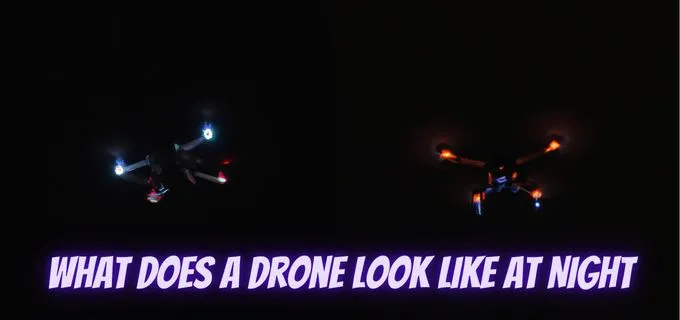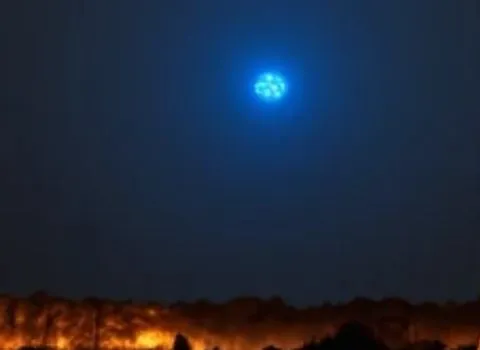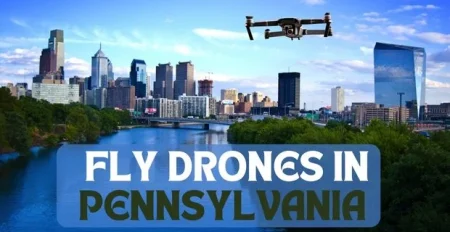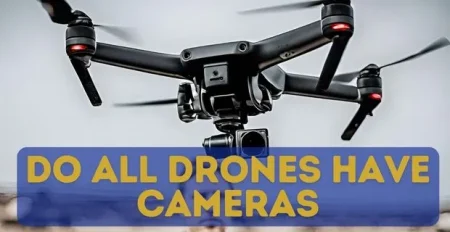
If you’ve ever been curious about the appearance of a drone in the night sky, this article is here to satisfy your curiosity. For those unfamiliar with drones, this post might not be your cup of tea. However, if you’re already acquainted with these airborne wonders and seek to learn more about their nocturnal presence, you’ve come to the right place.
What does a drone look like at night?
A drone is a compact flying device that a pilot can control remotely. Normally drones are equipped with luminous lights and wings, and they effortlessly glide through the air. In the darkness of the night, drones resemble tiny celestial bodies, twinkling like stars in the sky.
This article is a detailed Guideline about Drone Lighting and How drone looks at Night, We have divided our article into different parts, and you can skip to your favorite part from here.
In this comprehensive guide, we explore drone lighting and the appearance of drones at night. Our article is thoughtfully divided into distinct sections, allowing you to navigate to your preferred topic easily:
What does a drone look like at night?
What color lights do drones have?
Do drones have red and green lights?
What does a green light on a drone mean?
What does a drone look like at night?
Spotting a drone at night is easiest by looking for its lights. While a drone’s appearance stays the same day to night, visibility can be an issue without a light source. You can detect it by its sound if you are close to a drone. When the drone is airborne, its glowing lights make identifying against the night sky easier.
From how far I can see a drone at night?
The distance from which you can see a drone at night depends on several factors, such as the brightness of the drone’s lights, the presence of external light sources, and your own visual acuity. According to FAA guidelines, drones with anti-collision lights can typically be seen from at least 3 statute miles away.
However, this distance may vary based on the specific conditions of the environment in which you’re observing the drone. Remember that smaller drones or those with less prominent lighting might be more challenging to spot at night.
Similarly, the drone camera range can also differ at night, and you can find out how far a drone camera can see from here.
FAA drone night flying:
As of my knowledge cutoff date is September 2021, the Federal Aviation Administration (FAA) has specific guidelines and instructions for flying drones at night in the United States. These regulations are part of the Part 107 rules for commercial drone pilots but provide a good framework for recreational pilots. Note that regulations might have changed since then, so always refer to the latest FAA regulations and guidelines before flying your drone at night.
Key points include:
Always refer to the latest FAA regulations before flying at night, as rules may have changed since my knowledge cutoff.
How To Spot A Drone At Night?
Spotting a drone at night can be challenging due to limited visibility. However, some tips help you identify a drone in the night sky:

- Look for lights: Drones usually have built-in LED lights or anti-collision lighting systems that make them visible in low-light conditions. These lights typically blink or have a specific pattern, distinguishing them from other light sources like stars or airplanes.
- Listen for sounds: Drones often produce a noticeable humming or buzzing sound from their motors and propellers. If you hear such a sound, try to follow it to locate the drone.
- Observe movement patterns: Drones hover or move in different patterns than traditional aircraft. Watch for objects that exhibit unusual movement or change directions quickly, as this could indicate a drone.
- Use binoculars or a telescope: Enhance your visibility by using binoculars or a telescope to scan the night sky. However, remember that using these devices does not satisfy the FAA’s visual line of sight requirement for drone pilots.
- Monitor flight paths: Drones often follow specific flight paths or routes. Familiarize yourself with common flight paths in your area, which can help you spot drones more easily.
- Collaborate with a visual observer: If you are a drone pilot, having a visual observer can help you maintain the visual line of sight and spot your drone more easily in the night sky.
Remember, flying a drone at night may be subject to specific regulations and restrictions, depending on your location. Always comply with local laws and guidelines while operating a drone at night.
Techniques for observers
looking to spot drones at night, several techniques can improve their chances of success:
Using binoculars and night-vision equipment
Binoculars or night-vision devices can enhance an observer’s ability to spot drones at night, particularly when flying at a distance or in areas with low ambient light.
Observing flight patterns and behaviours
Understanding common drone flight patterns and behaviours can help observers identify drones more easily. For instance, multirotor drones often hover or make precise movements, while fixed-wing drones typically fly in straight lines or wide arcs.
Factors influencing drone appearance at night
The appearance of a drone at night is influenced by several factors, which can impact its visibility and the ease with which it can be identified:
Lighting configurations:
The type, colour, and placement of lights on a drone can significantly affect its appearance at night. Navigation lights, orientation lights, searchlights, and customizable LED lights contribute to a drone’s nighttime visibility, making it easier for pilots to maintain visual contact and for observers to identify the drone.

Drone size and design:
A drone’s physical dimensions and structure can also impact its nighttime appearance. Larger drones with distinct shapes may be easier to spot, while smaller drones might be more challenging to identify at a distance. The placement and design of propellers, rotors, and other components can further influence the overall appearance of a drone at night.
Environmental conditions:
The surrounding environment can affect a drone’s visibility at night. Ambient light from the moon, streetlights, or other sources can either enhance or hinder the visibility of a drone. Weather conditions such as fog, cloud cover, or precipitation can also impact the ease with which a drone can be seen and identified at night.
Altitude and distance:
The distance between a drone and an observer and its altitude can impact its nighttime appearance. As a drone moves further away or higher in the sky, its lights may become less distinguishable, making it more challenging to identify the drone’s make and model or to gauge its distance and trajectory.
What color Lights Do Drones Have?
Drones are equipped with various colored lights for different purposes, such as indicating orientation, enhancing visibility, and complying with aviation regulations. The most common colors for drone lights are red, green, and white, but customizable LED lights can also include a variety of colors. Here’s a detailed explanation of the different color lights found on drones:

Red lights:
Red lights are typically found on the drone’s left side (port side). They serve as navigation or position lights, indicating the drone’s orientation in the sky. Red lights help pilots and observers quickly determine the direction the drone is facing, particularly during nighttime or low-light flights.
Green lights:
Green lights are usually placed on the drone’s right (starboard) side, serving a similar purpose to red lights. It indicate the drone’s orientation and help pilots and observers identify the direction the drone is facing. The combination of red and green lights on a drone mirrors the lighting configurations found on manned aircraft, which helps maintain consistency and coordination in the airspace.
White lights:
White lights on drones can serve multiple purposes:
- Anti-collision lights: Bright, flashing white lights, also known as strobe lights, are used as anti-collision lights on drones. Anti-collision lights increase the visibility of drones to other nearby aircraft and help minimize the risk of collisions, especially during nighttime flights.
- Position lights: Some drones may have white lights on the rear or tail section, indicating the back of the drone. These lights can help pilots and observers discern the drone’s orientation and movement.
- Searchlights or spotlights: White lights can also be used as searchlights or spotlights, illuminating specific areas or objects on the ground during nighttime flights. These lights are useful for search and rescue operations, surveillance, or inspection tasks.
Customizable LED lights:
Some drones come equipped with adjustable LED lights that can be customized to display different colors, patterns, or animations to suit various mission requirements. These lights can enhance the drone’s appearance and visibility for creative purposes, such as drone light shows, advertising, or artistic performances. Customizable LED lights allow pilots to personalize their drones and create unique lighting configurations to suit their preferences and needs.
Searchlights and spotlights
Searchlights and spotlights are designed to illuminate specific areas or objects on the ground during nighttime flights. These lights can be useful for search and rescue operations, surveillance, or inspection tasks.
Searchlights and spotlights enable drone pilots to focus on a specific target or area, providing better visibility and enhancing situational awareness during nighttime flights.
Orientation lights
Orientation lights help drone pilots maintain visual contact with their aircraft during nighttime flights. It lights assist drone pilots in maintaining control of their aircraft during nighttime flights, especially when navigation lights are insufficient. They can help pilots discern the drone’s orientation, altitude, and distance more effectively.
| Colour | Purpose | Placement and Notes |
| Red | Navigation/Position light (port/left side) | Indicates the drone’s left side (port side), helping pilots and observers determine the drone’s orientation. |
| Green | Navigation/Position light (starboard/right side) | Indicates the drone’s right side (starboard side), helping pilots and observers determine the drone’s orientation. |
| White | The anti-collision lights (strobe lights) | Bright, flashing white lights to make the drone more visible and reduce the risk of collisions during flight. |
| Position light (rear or tail section) | Indicates the back of the drone, helping pilots and observers discern the drone’s orientation and movement. | |
| Searchlight or spotlight | Illuminates specific areas or objects on the ground during nighttime flights, useful for search and rescue operations, surveillance, or inspection tasks. | |
| Customizable LED lights | Creative applications (light shows, advertising, artistic performances) | It can be programmed to display various colors, patterns, or animations, allowing pilots to create unique lighting configurations for their drones. |
Why Do Drones Have Red Lights?
Drones have red lights for several important reasons, primarily related to visibility, orientation, and safety during flight. These lights, also known as navigation or position lights, serve specific purposes in the operation of the drone:

Indicating orientation:
Red lights are typically placed on the drone’s left side (port side). It helps pilots and observers quickly determine the drone’s orientation during flight, especially in low-light conditions or at night.
Enhancing visibility:
The red lights make the drone more visible in the sky, reducing the risk of collisions with other aircraft, obstacles, or people on the ground.
Complying with aviation regulations:
In many countries, aviation regulations require drones to be equipped with specific lighting configurations, including red and green navigation lights. These regulations ensure that drones are easily visible to other aircraft and observers, promoting air safety.
Mimicking manned aircraft lighting:
Red lights on drones follow the same convention used on manned aircraft, where the port (left) side has a red light, and the starboard (right) side has a green light. This consistency helps pilots, air traffic controllers, and other aircraft operators identify the direction and orientation of the drone, maintaining safety and coordination in the airspace.

So Drones have red lights to indicate orientation, enhance visibility, comply with aviation regulations, and maintain consistency with manned aircraft lighting conventions.
What does a green light on a drone mean?
A green light on a drone typically serves as a navigation or position light, indicating the drone’s orientation in the sky. It helps both the drone pilot and observers quickly identify the direction the drone is facing, particularly during nighttime or low-light flights.

Using green lights on drones mirrors the lighting configurations found on manned aircraft, which helps maintain consistency and coordination in the airspace. By recognizing the green light on the starboard side and the red light on the port side (left side), pilots, air traffic controllers, and other aircraft operators can better understand the drone’s orientation and movement, promoting safety and efficient operation during drone flights.
Do drones have red and green lights?
Yes, Many drones have red and green lights, which serve as navigation or position lights to indicate the drone’s orientation in the sky. The red light is typically placed on the drone’s left side (port side), while the green light is usually on the right side (starboard side).
These lights help drone pilots and observers quickly determine the direction the drone faces, particularly during nighttime or low-light flights. The use of red and green lights on drones follows the same lighting conventions used on manned aircraft, which helps maintain consistency and coordination in the airspace.
In addition to red and green navigation lights, drones may be equipped with white lights.
Drone blinking lights
Drones have blinking lights for several reasons, primarily related to visibility, safety, and communication of the drone’s status. These blinking lights, also known as strobe or flashing lights, can be found in different colors and serve specific purposes:
Anti-collision lights:
Drones often have blinking white lights, which serve as anti-collision or strobe lights. These flashing lights make the drone more visible in the sky, particularly during nighttime or low-light flights, and help reduce the risk of collisions with other aircraft, obstacles, or people on the ground.

Status indicators:
Blinking lights on a drone can also indicate its current status or mode of operation. For example, some drones have flashing red, green, or yellow lights to show different stages of the startup process, GPS signal acquisition, or calibration. The specific meaning of these blinking lights varies by manufacturer and drone model, so it’s essential to consult the user manual or documentation for the appropriate interpretation.
Low battery warnings:
Drones may have blinking lights to alert the pilot when the battery level is low, and it’s time to return for landing or replace the battery. These blinking lights can help prevent unexpected power loss during flight and ensure a safe return to the ground.
Signal loss or fail-safe mode:
Some drones may use blinking lights to indicate a loss of connection with the remote controller or activation of a fail-safe mode. In such situations, the drone may automatically return to its home point or hover in place until the pilot re-establishes the connection.
Customizable LED lights:
Certain drones have customizable LED lights programmed to blink or showcase different colors and designs. These lights are used for creative purposes, like drone light shows or artistic performances.
Conclusion
A drone’s appearance at night is a captivating fusion of technology and art, as its carefully designed lights serve practical and aesthetic purposes. The red, green, and white lights on drones assist with navigation, orientation, and safety and create a mesmerizing display that captures the imagination of onlookers. Customizable LED lights offer endless possibilities for creativity, transforming drones into dazzling aerial performers that paint the night sky with their vibrant colors and patterns.
Understanding the intricacies behind a drone’s nighttime appearance deepens our appreciation for the skillful engineering and innovation that goes into these aerial marvels. The next time you see a drone soaring through the night sky, take a moment to admire its enchanting display. It showcases the perfect marriage between functionality and beauty, leaving a lasting impression on all who witness its dance in the darkness.










